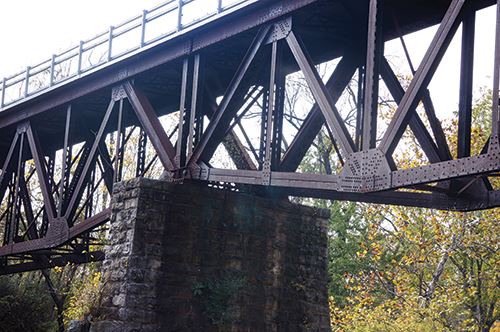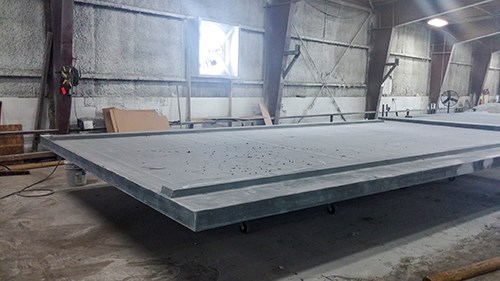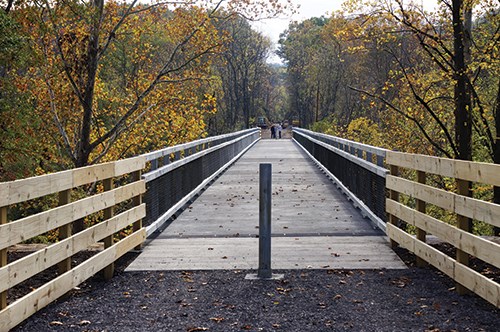Rails to trails
Composite deck converts old railroad span to pedestrian trail crossing.
The Rails-To-Trails Conservancy (Washington, DC, US) was formed in 1983 to re-purpose unused rail corridors nationwide in support of a growing network of recreational walking and biking trails. Broad Top Township in Bedford County, located between Pittsburgh and Harrisburg in southern Pennsylvania, participates in Rails-To-Trails through a local nonprofit organization. That group wanted to convert an abandoned HB&T railroad grade to a pedestrian- and bicycle-friendly trail that would connect two existing public parks, but was faced with having to do the same to an existing 108m railroad trestle bridge spanning a river that separated the parks.
The nonprofit chose to work with Composite Advantage (CA, Dayton, OH, US), for a new, FiberSPAN fiber-reinforced polymer (FRP) composite bridge deck. The deck needed to fit atop the old iron truss support structure. Although the latter was still structurally adequate, its two upper girders, on which the deck would sit, were spaced 3m on center, a wide spacing for a pedestrian bridge, says CA president Scott Reeve: “The wider the support spacing, the greater the deck depth had to be to meet deflection criteria under load of L/500.” (Maximum deflection equals spacing length divided by 500.) Further, says Reeve, “Unlike conventional bridge decks, old structures like the HB&T trestle bridge used girder flanges with rivet heads on top” (see second photo, at left). That prevented the use of a simple flat panel.
Given the distance between the girders and the exposed rivet heads, CA molded 15 4m-wide by 125-mm-deep sandwich-design deck panels, with upper and lower skins of fiberglass. To ensure they would seat properly on the girders, says Reeve, “the FRP deck panels were molded with integral spacers or steps on the underside to ensure the deck would clear the rivet heads.” (Steps shown in third photo at left were made to seat on the flat area between the rows of rivets on each large girder in the second photo.) Lastly, molded-in steel box tubing on the outer edges provided a high-strength load path for support when railing posts were attached.
A Broad Top Township crew bolted down the FRP deck panels to threaded shear studs welded to the tops of the girders. The FRP deck panels took just three days to install and the HB&T bridge and trail opened to the public in November 2014.
Related Content
-
Swedish parking garage to incorporate decommissioned wind blades
Architect Jonas Lloyd is working with Vattenfall to design the multistory building with a wind blade façade, targeting eco-friendly buildings and creative ways to remove blades from landfills.
-
Sustainable Infrastructure Systems creates fiber-reinforced post-consumer plastic structural panels
Australian composites manufacturer offers a scalable building solution, already established in a pedestrian bridge application, to tackle unprocessed soft plastics waste.
-
Bio-based, fire-resistant composites become mainstream
Projects use Duplicor prepreg panels with highest Euroclass B fire performance without fire retardants for reduced weight, CO2 footprint in sustainable yet affordable roofs, high-rise façades and modular housing.

















